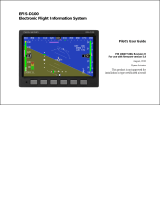
AFMS, Garmin GNS 480 GPS/SBAS System 560-0985-01 Rev. H
FAA APPROVED Page 9 of 12
2.7 GDL 90 Control
The GNS 480 in this installation IS configured is NOT configured to
control a GDL 90. If the GNS 480 is configured to control a compatible
transponder (SL70, SL70R, GTX 32, GTX 327, GTX 33, or GTX 330) and the
transponder provides control to a GDL 90 UAT Datalink Sensor:
a) The GDL 90 does not replace any required equipment.
b) The GDL 90 UAT datalink is approved for Air Traffic Control (ATC) ADS-
B Surveillance Services in the United States. For areas where ATC
Surveillance Services are provided, the UAT equipment shall broadcast
aircraft position, velocity, barometric altitude information, flight
identification and/or a 4096 squawk code.
c) When directed by ATC to turn “off” the ADS-B transmission, pilots should
use the GNS 480 transponder standby function (press XPDR, then STBY) to
stop ADS-B transmissions while airborne or on the surface.
UAT datalink is also used to receive Traffic Information Services-Broadcast
(TIS-B) and Flight Information Services-Broadcast (FIS-B) information. To
receive TIS-B and FIS-B information, a display will be needed.
2.8 Flight Plan Display Limitations
The GNS 480 serial 429 data output has been evaluated with the Sandel 3500
series EHSI and Bendix King 40/50 series EFIS system.
For Bendix King 40/50 series EFIS installations, the serial data output must be
set according to the GNS 480 installation manual. The display is limited to the
types of flight plan legs that can be displayed. Holding patterns, procedure
turns, DME arcs, and heading legs cannot be displayed on the system. Pilot Nav
legs cannot be displayed. Refer to the GNS 480 for display of the active leg type
and guidance.
For Sandel 3500 EFIS HSI installations, the GNS 480 serial data output must be
set in accordance with the installation manual. The display is limited to the types
of flight plan legs that can be displayed. Heading legs cannot be displayed.
Pilot Nav legs cannot be displayed. Refer to the GNS 480 for display of the
active leg type and guidance.
2.9 Holding at the Final Approach Fix
The GNS 480 can automatically or manually insert holding patterns at any
waypoint. In the event that a course reversal or holding is accomplished at the
designated approach FAF, holding patterns within 6.5 degrees of the inbound
course will be adjusted for local magnetic variation at the FAF. Depending upon
the degree of variation, this will cause the inbound course on the flight plan page
to vary slightly. The automatically or manually inserted hold guidance will
function normally. Holding patterns at other waypoints will use the locally
calculated magnetic variation.















